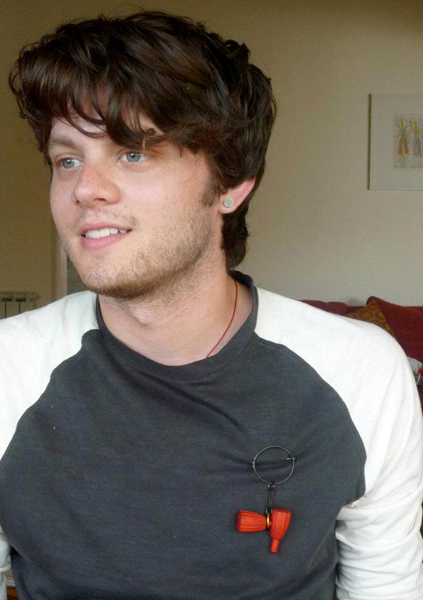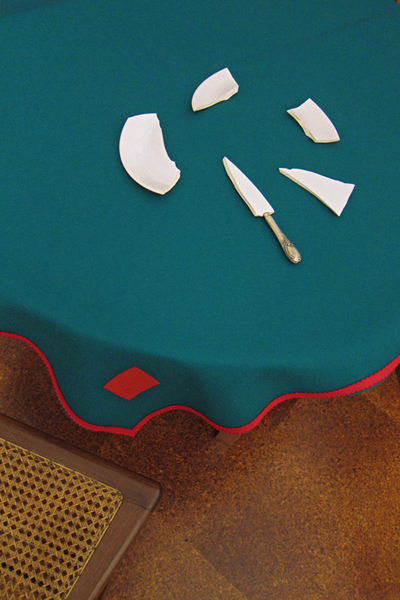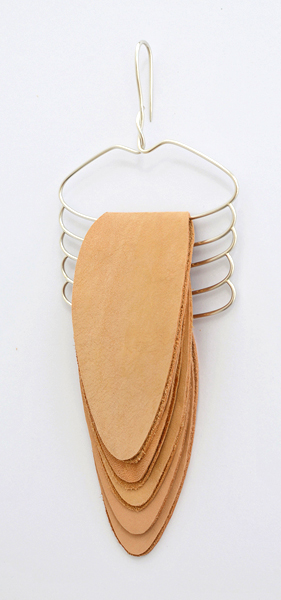
Aaron Decker: When did you start studying jewelry?
Leonor Hipolito: 1994. I started studying sculpture in Lisbon, Portugal at Ar.Co (School of Art and Visual Communication) and had a technical education at School Contacto Directo. I wanted to continue with sculpture, but then I switched to jewelry. I was very focused on the relationship of the objects towards the body and jewelry deals with both, the scale and portability. I find it interesting that an idea disseminates through an object that travels, while larger sculptures often are static and may only work in a specific environment. Jewelry is an art form that is in a constant clash with different environments.
After my studies at Ar.Co I felt like continuing and decided to study in Amsterdam at the Gerrit Rietveld Academy. This idea came to me during a workshop in Ar.Co, when I met Ruudt Peters, who was the head of the department at the Rietveld Academy. In 1998, half way through my studies at Rietveld, I took part in an exchange program at Parson’s School of Design, where I found some further inspiration. I studied metalwork, but also digital design and history of fashion. The education was much more technical than at Rietveld. Parson’s atmosphere was very intense and busy. It was interesting to find a different approach to my work and like that it was a nice break for getting a fresh perspective.

After school what was your work like? Did the kind of work you did in school continue, or did it change?
Leonor Hipolito: My exam work, Tools for the Subconscious, was crucial for me to find my way, along with my previous work, Gestures. I started with Gestures in 1997. That was in my second year of jewelry. Like in many other schools, you had assignments in the first two years from many different teachers that oriented us towards having an idea to explore in our work, rather than constructing it. I emancipated myself from this way of working in the second year with my project Gestures. Exploring Gestures took me two years (1997-1998) and it gave me confidence to start a series of objects. To work on a series was a way to dig deeply into one idea, less heterogeneous than in the assignments of the first two years. I wanted to develop one idea in full.
After my final exam I came back to Portugal and continued the last line of my work, Tools for the Subconscious, because I believed it had potential still to be explored.
During the years I have changed here and there, the work shifted into many veins. Recently, when I was interviewed by Cristina Filipe, who is doing research on Portuguese jewelers, we were looking at the breadth of my work. Let me say that I am not a person who often looks to the past and digs into her work, as I am always pushing forward. But during the moments I was looking at the history of my work I realized that for the past fifteen years I have been very constant in the things I like and in the forms I use. Even though the work from series to series can be very different, it all makes sense. It is all me, all Leonor! A funny thing I realize is that now there is such a strong relationship to my first works. In between then and now there were many ruptures, many breaks. I am very experimental in that sense, very dynamic in finding new ways to answer questions like, ‘What do I want to communicate? How do I reach people with my ideas? How am I going to exhibit? How am I going to sell my work?’

Leonor Hipolito: In my last exhibition Beyond Emotions I like something very much about the writings, published in the exhibition’s catalog. I did combine text and jewelry already before in my project überstein, when I was an artist in residence in Idar-Oberstein, Germany. Back then, überstein was a kind of diary for me, a compilation of jewelry with text. For Beyond Emotions the text came first and then came the pieces. It is not like the writings are descriptions of the work; they are complementary. The works and words are in dialogue.
But to answer your question I think the main subject of my work is the emotional relationship between people. The things that you are most reserved in dealing with. For instance, to express love for a person, or certain physical and psychological gestures that express what you are feeling through your hands, the subtle things that you normally are not conscious about. I am also interested in the relation between us and society, but not only between human beings but also towards our surroundings. How do we deal with it and what kind of separation we construct between nature and us? I like to unite and make the gaps smaller. I am not very political in my work and wouldn’t like to impose things. Often I have questions for myself and use them to tickle people’s thoughts. I realize that people often see within my work images of anatomy and they are right. I am fascinated with anatomy. I can see a lot, not only forms, but also their iconic and symbolic nature. In my work the body still plays a strong role. When depicting the forms, I am not so much concerned about accuracy but rather in catching the essence of what a specific shape can mean and how it links with your imagination. Using formal language to form a concept.
What do you look at for inspiration?
Leonor Hipolito: I look at nature, dance, anatomy, medical instruments, poetry and people inspire me, not to mention different artists. I am inspired by many different things. I prefer to remember how that thing, thought, person or instance touches me. It is very much about instinct and about feelings.

Leonor Hipolito: What affects me most is when humans play superior. This mentality that we are independent and separate from nature. All things come from nature and we are nature too. I think it is more beautiful when we unite with nature because there is more balance and this separation, I believe, makes us dumb. I have this fascination with looking at anatomical books and seeing these shapes, patterns and structures, then looking around me and seeing them again everywhere. Everything in our constructed environment and in nature, it is all from the same fiber, we are all composed of atoms. For me it is all very much the same! For example, when I made the work Gaia, it is not that I necessarily believed in the philosophy, but it was a fascinating thought to imagine the earth as an organism. I think it is beautiful that a person can come to that conclusion. I really see similarities in the shapes both around us and within us. I have a relation of respect with nature.
Being a born in Portugal, do you think there is a Portuguese identity to your work?
Leonor Hipolito: There must exist something Portuguese in what I do. I think Portuguese people in general are very poetic. There is a poetic image of this country at the end of Europe looking into the ocean, like this word Saudade – longing. There is a lot of this, but also hope. I think my work is about hope too. I am not the Portuguese stereotype whatsoever. It is funny because many people still ask me where I come from. I went to Holland when I was 20 years old, very young and like a sponge. I think the spirit of the Rietveld Academy really influenced me but I wouldn’t say that I have a Dutch style. What is the Dutch style? There were many nationalities there and most of my colleagues were from abroad. My working method comes from this time and place and it became me, it became Leonor’s process and system. Since my background of studies is not Portuguese, my method is very different than the ones taught here. And then I have lived with my husband, who is German, for seventeen years now and that influenced me a lot too. I am more pragmatic now. And we speak in English on a daily basis and that made English a very emotional language to me. When I write about emotions I often write in English. So in total I would say that I am an international Portuguese.
Do you think that Portuguese jewelry is shown abroad enough?
Leonor Hipolito: No, not yet, I think. When I participate in international group exhibitions I look at how many countries are represented. I am always curious to see who else is coming from Portugal with me and unfortunately I am often alone. These exhibitions usually concentrate the same names, but in recent few years things are changing. PIN (Associação Portuguesa de Joalharia Contemporânea) and Cristina Filipe, who co-founded it, are working to promote and show that there is an active Portuguese jewelry scene. If you think about Germany, Holland, Sweden or Spain, to mention a few, there is more opportunity in these places to show work. And here it is pretty hard to make work for a living, so Portuguese jewelers don’t have such an intense free production process. It demands a lot of investment and a lot of availability from you to always produce and show. I know it, because I am a crazy one, producing constantly and trying to follow my ideas and getting them out into the world. It is hard, it’s a huge investment, often without return, but you push on.

Anything new on the horizon?
Leonor Hipolito: Right now I have slowed down a bit because I was producing a lot for my last exhibition Beyond Emotions, from April until May 2012 here in Lisbon. That work took me one and a half years. I was very demanding with the results and became very pleased with them. I did everything by myself, from texts to work, as well as setting up the show. Tons of drawings and experiments, all very time consuming. After that I got into a sort of slump. That kind of moment you need to refresh your thoughts and plan new steps ahead. Now I have many new ideas and I am in the process of selecting and being very demanding of myself once more. I want something to be profound. Now, working for me is more difficult, because I put more demands on myself. You don’t want to play, not just fun, but make something that is powerful and speaks for itself. Many plans, work in progress.





